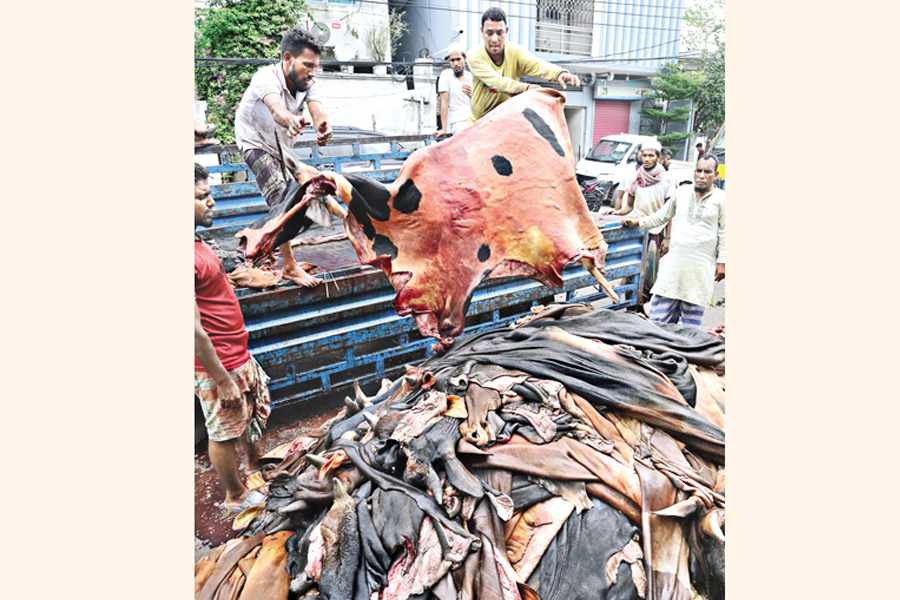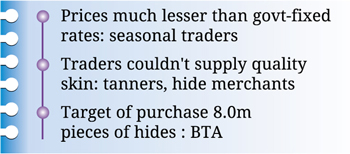Hide traders as govt-set prices go unheeded
Animal sacrifices rise 3.7pc at this Eid: Ministry of Fishery and Livestock

Published :
Updated :

 Seasonal traders and rawhide merchants squabble over prices as the government-fixed rates largely go unheeded during the nearly trillion-taka total Eid-fiesta business binge this year.
Seasonal traders and rawhide merchants squabble over prices as the government-fixed rates largely go unheeded during the nearly trillion-taka total Eid-fiesta business binge this year.
On the one hand, the seasonal traders allege that rawhide and skin merchants, who collect the rawhide and salt-treat them prior to selling to the tanners, offered them prices much lower than the buying rates they paid.
On the other side of the trade, merchants said rawhide brought by the traders lost the quality for delayed transportation or not in a good shape. Besides, they had to spend an additional Tk 250-Tk 300 to procure the hides.
A firsthand account of the fast-running trade processing unfolds ground realities. During a visit to old Dhaka's Posta, a biggest hub for rawhide trade in the capital city, the FE correspondents found most rawhide shops finalising the procedure to preserve the rawhide with salt.
A limited number of sellers were still coming to the area on the third day of Eid-ul-Adha occasion, an Islamic ritual observed through sacrificing animals.
Traders said the prices of different categories of raw cowhide were below the government-set rates. Besides, per piece of goatskins was selling at a throw-away price of Tk 10 only, and some were even given for free to avert a rot.
Following a meeting with all stakeholders, the government had earlier fixed the prices of salt-treated rawhide of cows at Tk 55-60 per square foot (sqft) in the capital city, Dhaka, and Tk 50-55 per sqft outside Dhaka-in an increase of Tk 5.0 compared to the previous year's.
The official pricing is applicable to the salt-treated rawhides whereas the trading in rawhide takes place for several days after the Eid-ul-Azha slaughtering of sacrificial animals.
Seasonal traders said the rawhide merchants were offering between Tk 200 and Tk 900 depending on the size and quality of rawhides.
Sakibul Islam from Rampura area sold 15 pieces of cowhides to a skin merchant at Posta on Wednesday noon, which fetched him a total profit of only Tk 1500.
"Traders are very much reluctant to give us fair price on different excuses," says Islam, adding that he could hardly make a balance on Tuesday after selling 40 pieces of rawhides.
In response to a query, he said the rawhide trade hardly brings profit nowadays since cost of everything, including labour and transportation, has marked a significant rise in the wake of inflation-fuelled general price rises.
"After 2010 the situation started worsening for the trade," he added.
A rawhide merchant, Nasir Uddin, who collected more than 3,000 pieces of cowhides this year, also was not happy with the trade ambiance.
Expressing dissatisfaction over the overall rawhide deals, he said, "Buying rawhide during Qurbani (Eid-ul-Azha) has become a pain since seasonal traders make continuous allegation against us."
Underscoring the need for presence of seasonal traders, Bangladesh Hide and Skin Merchants Association Chairman Md Aftab Khan told the FE that it was not possible for the regular traders to collect all the hides.
"We have successfully bought the rawhides since Eid day following due procedure," he said, adding that no event of indiscipline was reported as of Wednesday noon.
Posta's merchants have already procured around 0.1 million pieces of rawhide as per their target this year, said the trade-body leader, adding that the old hub used to collect over 0.3 million pieces several years ago.
Regarding an allegation made by the seasonal traders, Mr Khan ruled out any scope of syndication and offering lower price.
"Rawhide is a highly perishable item. A trader needs to act fast to preserve them as well as he cannot buy rawhide more than their capacity to preserve," he said about the tricks of the trade in leather sector which is up and coming on the global export market.
"Many seasonal traders don't maintain the quality of rawhide as well they come late, resulting in lower offerings for the rawhides," he added.
Besides Posta, skin merchants collect rawhides in Hazaribagh, Hemayetpur and Tannery estates in Savar.
Tanners will start collecting the salt-applied rawhides soon at the height of trade processing.
Also, tannery owners gathered approximately 0.5 million pieces of rawhide, Chairman of the Bangladesh Tanners Association (BTA) Shaheen Ahmed said.
"So far, around 0.5 million pieces of raw leather have been collected in the Savar Tannery Estate. We are purchasing high-quality rawhides at government-fixed prices," said the BTA chairman.
He was addressing a press conference at the Dhanmondi Convention Hall on Wednesday noon to clear any mist over the bustles.
The BTA has set a target of collecting 8.0 million pieces of rawhide this year, which is 1.0-million less than the previous year's target.
Ahmed focused on the improvements in the collection, storage, and transportation systems for raw leather, attributing these advances to collaborative efforts of the government, local administration, and tannery owners.
Additionally, Ahmed noted a positive change in the application of salt to raw leather, which is expected to preserve the quality of the rawhide for a longer period.
Asked, BTA secretary Sakhawat Ullah told the FE that rawhide price is determined by the Bangladesh Trade and Tariff Commission, dealers at Posta, various leather-sector organisations, and international-market rates.
"This pricing is based on real ground and not the decision of any single entity," he said.
Mr Ullah also mentioned financing constraints. Last year, tanners received Tk 2.7 billion in loans from banks. This year, only Tk 600-700 million was approved, which he considers insufficient for such a significant industry.
As a result, tannery owners have had to secure additional funds from various informal sources which pushed up the interest rates, he said.
Currently, 142 tanneries are operational at the Savar Tannery Estate, but not all are certified by the International Leather Working Group (LWG), he mentioned.
He expressed a desire for at least 20 tanneries to receive LWG certification initially, noting that tannery owners are prepared to provide the necessary support.
However, he emphasised timely government intervention to get to this goal of expansion of the industry.
"With proper initiatives, a few tanneries could obtain LWG certification within the next year, which would help boost the leather market further," Ullah said.
Eid-ul-Azha is the key trading season for rawhides, as nearly 80 per cent of the annual skins are collected during this time.
According to the fisheries and livestock ministry (MoFL), the number of sacrificed animals increased 3.7 per cent to 10.4 million this year.
Meanwhile, for the past few years, the prices of rawhides during Eid-ul-Azha have seen a steep decline, primarily due to the dominance of hide merchants.
This trade trend has given rise to charity as it prompted many individuals to donate leather to orphanages and madrassas, particularly during the Eid-ul-Azha festival.
This year, the absence of seasonal leather traders was notable in most parts of the capital on Eid day, said Azizur Rahman, a resident of Chairman Goli in West Dhanmondi.
Rahman said he bought a sacrificial cow at Tk 0.18 million while a local trader offered him only Tk 550 for the hide.
"I later donated it to a nearby orphanage-cum-madrasa at Jafrabad in West Dhanmondi area."
He said like him, many people donated the sacrificial hides to nearby orphanages and madrassas instead of selling them.
However, many madrasa students and teachers were found actively collecting animal skins free of cost using vans in different areas. These raw hides are then brought to street corners where they attempt to sell them.
Furthermore, several orphanage-cum-madrasas are preserving raw hides by applying salt. This method allows them to store the hides until they could be sold to various vendors at a later time.
Arifur Rahman, a student of East Rayerbazar Mosque and Madrasa in the city, explains: "Many people donate the skins of sacrificial animals to madrasas. This year is no different. We also receive skins from the animals we slaughtered."
After collecting the hides, they immediately sell some to traders. Those that cannot be sold are preserved with salt and stored until they could be traded later.
Our Chattogram correspondent adds: The seasonal and permanent leather traders collected a large amount of cattle leather at very low prices this year. They collected around 0.4 million pieces of leather from the day of Eid Ul Azha to Tuesday.
The Chattogram District Administration has taken special measures to ensure the preservation of the raw leather until it was transported from the field to Dhaka.
Abul Bashar Mohammed Fakruzzaman, the Deputy Commissioner (DC) of Chattogram, said, "In collaboration with the Upazila Nirbahi Officer (UNO), raw leather is stored in multiple specific sheds from the day of Eid in 16 upazilas of Chattogram."
An adequate number of cattle did not arrive in Chattogram markets before the Eid day on June 17. It is estimated that around 0.6 million cattle were sacrificed this year.
Unfortunately, the individuals who sacrificed cattle for Eid Ul Azha did not receive fair prices for their leather this year.
Seasonal leather traders purchased leather from them at prices ranging from 150 to 250 taka per bull leather.
In conversations with The Financial Express, almost all individuals who sacrificed cattle alleged that they sold their leather at very low prices.
tonmoy.wardad@gmail.com
saif.febd@gmail.com
nazimuddinshyamol@gmail.com


 For all latest news, follow The Financial Express Google News channel.
For all latest news, follow The Financial Express Google News channel.